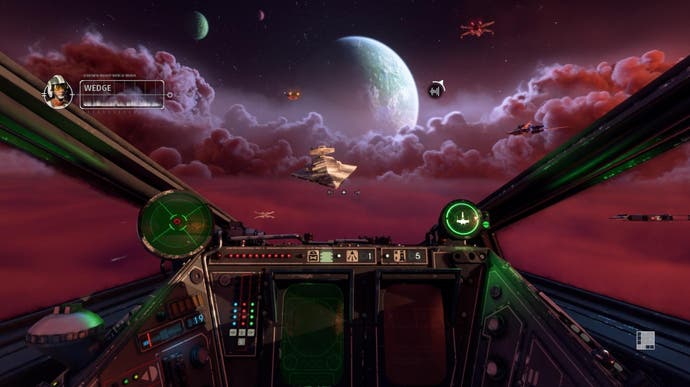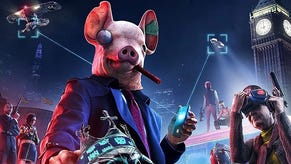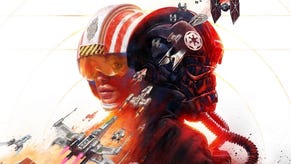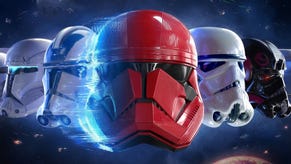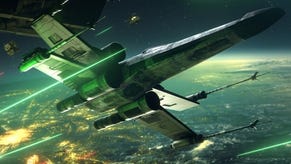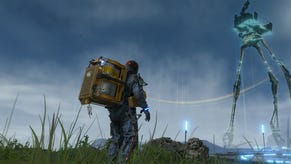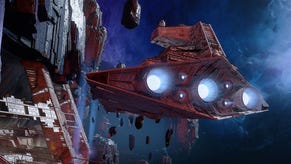Star Wars: Squadrons review - a scrappy, compelling starfighter that excels in VR
Double A-wing.
If there's one thing I've learned over the last few days, it's this: being a pilot in the Star Wars universe is brutal. I have newfound sympathy for Porkins, the rebel pilot who briefly appeared in A New Hope, who must have entered his cockpit full of adrenaline and aspirations... only to have it all end with a stray laser. This is the reality of flying through the chaos of space battle, and Squadrons wants you to know it.
Made by Motive Studios, Star Wars Squadrons is really a game of two halves - in several senses of the word. Split into a ten-hour campaign and two main multiplayer modes, both sides somehow feel completely different despite sharing the same set of controls, with the story favouring immersion and the multiplayer providing more of the compelling star-fighting experience I was looking for. The latter is where Squadrons' gameplay truly comes into its own, and is only made better when experienced in the terrifying beauty of VR.
Before you get stuck into the multiplayer, however, you'll probably want to test your piloting skills in the game's campaign mode - which has its moments, but never quite reaches the same heights as the multiplayer.
Set after the destruction of the second Death Star, in the strange limbo between the original trilogy and the sequels, Squadrons tells the story of two elite forces as they battle to wrest control of a new weapons project developed by the Rebellion New Republic. The player flits between the Empire's Titan and the New Republic's Vanguard squadrons over the course of several chapters, giving the campaign a nice sense of flow and progression. There's plenty of military fluff thrown around, but the personal tussle between Empire commander Terisa Kerrill and her former (now-defected) senior Lindon Javes manages to cut through the noise and keep you engaged.
Due to its placement in the Star Wars timeline, Squadrons' story was always going to be limited in terms of impact on the wider universe - so don't expect any history-defining moments in this campaign. At times this becomes a little unsatisfying, as there's a sense the progress you make on one side is immediately overwritten by the other (particularly towards the end where I really did feel quite cheated). Yet Squadrons' story is more about personalities and unique missions, with a smaller-scale focus on individuals, their backgrounds, and how they've dealt with the power shift caused by the destruction of the second Death Star. Mimbanese alien Gunny is a particular stand-out, exemplifying the tough can-do attitude of the New Republic, while Empire veteran Shen is notable for his series of grunts and his absolute refusal to remove his helmet. Which apparently stays on, er, all the time. The squad members provide a glimpse of wider life in the galaxy beyond the battles, and listening to their stories is a lovely breather in-between intense missions. And yes, Wedge does make an appearance.
The campaign really is a tale of mission moments, and these are the points that burn brightest in the memory. On several occasions you're encouraged to squeeze through tight tunnels or carefully steer inside a massive spaceship, in a nice call-back to the destruction of the second Death Star. At one point I found myself chasing a ship through a large piece of space debris, in a moment that felt surprisingly organic and unscripted. Another particularly memorable mission requires you to escape an asteroid field as a massive explosion takes place behind you, putting your navigation skills to the test under heavy pressure.
A rather major function of the campaign, however, seems to be teaching the player how to operate the controls, sort of like an extended tutorial for the multiplayer. Squadrons' mechanics centre on transferring power to your engines, weapons or shields depending on the situation - or your ship, as some can swap power between the engine and weapons while others can shift shields between the front and rear. The story does a fair job of teaching you all this, but at times the way missions are explained can be a little bewildering for newcomers: the tutorial for space drifting stands out as a particularly confusing section, while the UI can be a little unclear when pointing you towards an objective, particularly in the midst of chaotic space battles. At times it's also guilty of over-steering the player in certain missions - that asteroid escape scene being one example, where the player has to escape via a very specific route instead of being given the freedom to find their own way out. Funnily enough, out-flying an explosion becomes a lot less tense when you have to slowly follow one character to the exit.

Squadrons' story does a lovely job at mood-building and painting the Star Wars universe, but it never really feels like the heart of this game. It has a sort of hollowness I can only really attribute to its AI dogfights: a lot of which are spent rolling around looking for the next target, and trying to swat your way through the enemy masses like a cloud of flies. Out of curiosity I upped the difficulty to Ace, which promised a more "realistic" experience with everyone given lower health, but this mainly increased the chaos of battles to the point where it felt unfair: I could be taken out by a stray AI enemy that would happen to crash into me, or a piece of debris, or a random laser from a ship the other side of the map - none of which would really give me much time to respond. This might be true to what a space battle would be like in reality, sure, but is it fun? Hmm.
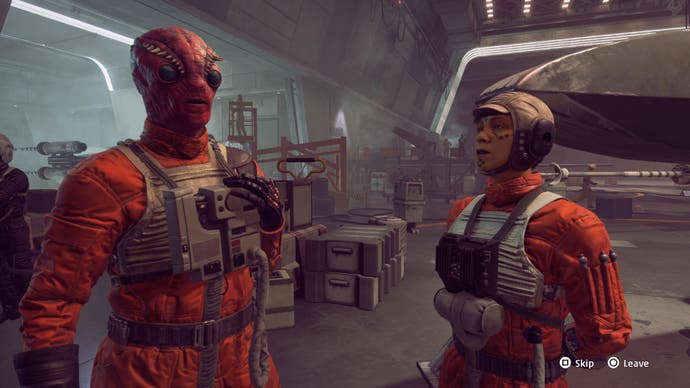
At this point I should probably mention that Squadrons really does feel like a game designed for VR (I tried it using PSVR, if you were wondering). The story sort of feels like a Disneyland ride, with the player teleported between rooms to have characters talk at them in one-sided conversations like animatronics. By no means is this a bad thing, however, as soaring over a Star Destroyer in VR is truly thrilling. You get an incredible sense of scale when flying past these enormous spaceships, while the vibrant backdrops of shimmering nebulae and shattered planets are mesmerising. I used the game's practice mode to simply sit in my ship and marvel at the view around me, and even spent some time just admiring the way light falls into the cockpit. You should absolutely take the opportunity to look behind you when playing in VR, as each cockpit is carefully crafted to tell the story of that particular ship. Larger craft are given military seats and grab handles, TIE Bombers show mysterious locked doors to the second cockpit, while Y-wings feel like the back of a cluttered station wagon from the 70s. I'd also never really thought about how dark and constricted a TIE Fighter feels inside, with only a couple of small portholes at the back, as if the pilot is blinkered into focusing on the target in front. It feels like a very imperial way of doing things.

VR also brings something extra to the multiplayer, and I could really feel the intensity of someone bearing down on me as I ducked and weaved my way through a shipyard. Dogfights have a simple premise - kill as many of the other team as you can before they kill you - but the opportunity to chase other players without AI interference results in some brilliant games of cat-and-mouse, introducing psychological mind games you simply don't get in single-player. It's been fascinating to watch other players gradually learn how to shake pursuers, or discover new routes and hiding spots to avoid detection. Nothing beats the unstoppable feeling of achieving a kill streak, particularly once you've mastered the controls and can fluidly switch from hammering your weapons to space drifting your way out of trouble.
If you're wondering how Squadrons prevents players from engaging in endless loop-the-loops to kill each other, the answer lies partly in map design (with most providing plenty of cover), but also in ship loadouts - which play an enormous role in the game's multiplayer. Using starfighter components unlocked through gaining experience, there are options to mess with your base stats such as shield health and speed, but Squadrons also gives you a number of tools to deal with pursuers: including seeker mines that can be dropped in your path, or turrets that automatically fire on enemies. Alternatively you can just use the ping system to scream for help, that works too.
In Squadrons' other multiplayer mode, Fleet Battles, switching between loadouts and ships forms an integral part of battle strategy. In the early stages players will need to pick niftier ships for the initial dogfight, with the aim being to achieve more kills and swing the battle morale meter in their favour (allowing them to begin attacking the enemy). Once on the attack, players can switch to heavy bombers to deal some damage to enemy capital ships - or perhaps select a support craft with a repairs loadout to help their squadmates under heavy fire. I've had a great deal of fun simply messing around with loadouts to create ships for every situation - be it attack, defence or middle-ground dogfighting - although my personal favourite is a support ship I've customised with an ion laser beam to disable enemies just as they swing past my turret. ("It's a trap," I mutter under my breath as an enemy swings past.)
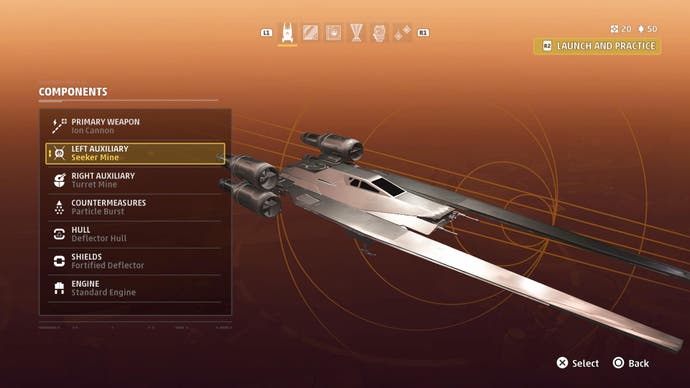

Learning when to time your attacks, switch power to your engines, or swap ship loadouts means there's a fair bit of depth to the multiplayer battles, despite the game only really having two proper multiplayer modes. That's not to say the multiplayer is without its flaws: there are several simple features that would make it so much better, like including an option to roll into the next match rather than returning to the main menu. I suspect some balance changes will need to be made to adjust ship stats and loadouts, as I've noticed a worrying tendency for some TIE Bombers to simply turn themselves into unmoving turrets in the middle of dogfights, which isn't exactly in the spirit of things. Capital ship AI has also been made rather powerful to prevent spawn camping, but it feels a little overzealous when the game is encouraging you to bomb the main enemy ship, and being killed by the AI instead of a player always feels a little disappointing. This is a problem that can be countered by good squad communication, but unless you're playing with friends or willing to use a mic, the game's ping system often isn't enough to spur everyone into a coordinated attack.
Squadrons also seems to have fallen into that age-old multiplayer problem of under-rewarding support work, with too much focus placed on kill/death ratio. The way individual scores are calculated is quite opaque, with healing supposedly feeding into your total score, but it generally feels easier to earn points by killing players rather than doing damage or assisting others. Peeking at your progress on the career tab will only show you your win/loss and K/D ratios, rather than anything such as healing, kill assists or average match score. Imagine my disappointment when I realised my 22 kill assists, gained from disabling ships with an ion laser for my teammates to then dismantle, were not really recognised in my overall stats. It's entirely possible to ignore all this and play for the sake of the team, but Squadrons could do more to push people into thinking beyond simple dogfights into carrying out objectives and trying different roles.

So, like the force, there's some balancing work left to do here, but despite all this Squadrons' multiplayer really has its hooks in me. Over the last week I've spent every day raring to get back in the cockpit (and I've developed a frankly worrying amount of bloodlust in my desire to hunt down players in my TIE Interceptor). When played with friends, dogfights are a scramble of yelling and hunting down specific players, resulting in some extremely silly battles with plenty of crashes. If you have a VR headset, this game is something that has to be experienced, both for the rush of competitive multiplayer and the mood-building of the story campaign. Squadrons is a bit of a bumpy ride, but it can be a thrilling one - and this bucket of bolts will get you there in the end.
